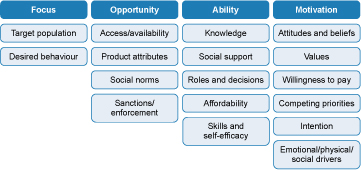8.2 Analysing and explaining behaviours using a FOAM framework
A number of frameworks have been developed specifically for use in the WASH sector. We are going to concentrate on a framework called FOAM, which stands for Focus, Opportunity, Ability and Motivation (Devine, 2009). The FOAM framework is shown in Figure 8.1. (Note that this version of FOAM is sometimes called SaniFOAM, when it has a particular focus on sanitation.) This is a comprehensive approach that expands on our simple framework above by asking us to think in more detail about the determinants affecting the behaviour that we want to change. Behavioural determinants are the reasons why people do or do not practise a given behaviour. Behavioural determinants can be internal (such as a belief about menstruation habits) or external (such as regulations against open defecation). The FOAM framework groups behavioural determinants under four headings.
In this framework:
- focus identifies the target group and the behaviour that needs to change
- opportunity includes questions around whether someone has the chance to change their behaviour
- ability looks at whether someone is capable of changing their behaviour
- motivation explores whether someone wants to change their behaviour.
Through these indicators, FOAM can be used to:
- define and prioritise interventions that aim to change behaviour
- analyse results of studies
- inform the design of new research and data gathering.
So how do we put it into action? In the rest of this session we will look at understanding Focus, Opportunity, Ability and Motivation in more detail and explore some tools that will help you gather the information you need to understand the current situation for a behaviour that you want to change.
8.1 Assessing behaviour in the context of hygiene and sanitation

